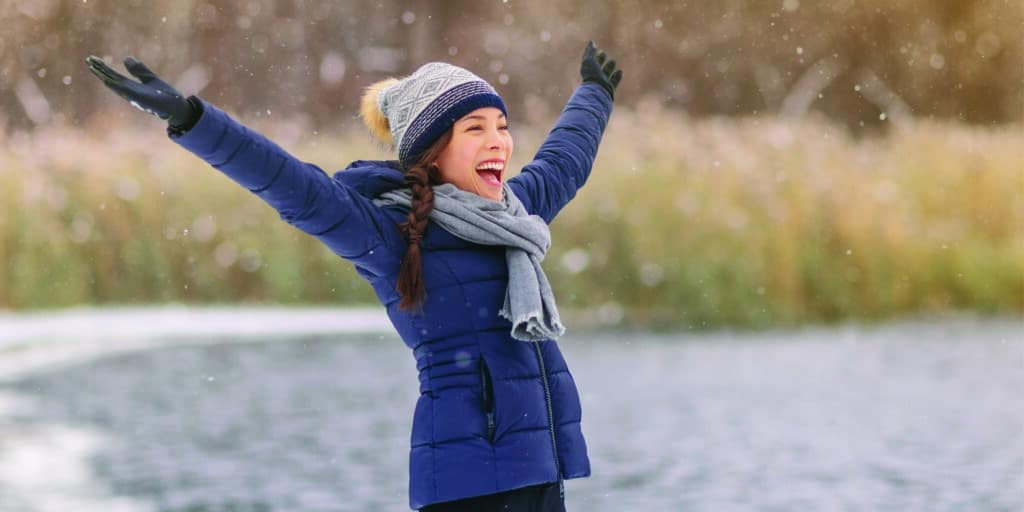A Guide To Layering for Fall (and Winter)

The early mornings are now dark and the days are shorter. Fall is here and winter is around the corner. You can feel and see it happening. If you have just moved to Colorado or a seasoned resident, you will know that our weather can change on dime. Whether you are strolling the sidewalks or on top of Mt. Blue Sky – the temperature and weather can shift dramatically. Hence the cliché, “if you don’t like the weather, just wait 5 minutes and the weather will change in Colorado.”
In case you want to know the difference between climate and weather, according to the National Ocean Service, “climate is what you expect and weather is what you get.” That said, weather is what you see outside on any particular day and climate is the average of that weather.
So how to do you prepare and dress for some of Colorado’s unpredictable weather? The simple answer is layering!! Merriam-Webster defines this term as wearing several pieces of clothing on top of one another. For Coloradoans, this can become an art in keeping warm and dry.
So where do you begin to maximize the layering benefits? It is as simple as 1 – 2 – 3!
- Start with the basics and a thin base layer – Synthetic moisture wicking fabrics like polyester or nylon can be worn as a base layer next to your skin. Wool and silk are also recommended for warmth and wicking though wool may not agree with everyone. This layer should trap in heat, be comfortable and will vary as the temperature changes. For example you might be comfortable wearing a synthetic t-shirt under a sweater in October but by November, a long sleeve base layer or turtleneck might provide that extra warmth. Remember to layer your legs with a pair of tights or thermal underwear under your pants or skirt.
- Then add a mid-layer like a sweater that has room enough to “give” and trap the warmth without feeling squished or tight. If you tend to run cold around the middle, add a fleece vest over the second layer. If you know that you tend to warm up quickly but want versatility, consider a layer with a zipper or buttons that can easily open to allow the heat to escape.
- Finally the thickest layer is your warmest and most protective item like your coat or jacket. Wool is always the best option for the outside layer though the trend these days are puffer coats with either down or synthetic fillers but make sure they are waterproof so you don’t get cold and soggy.
Ok, there might even be a fourth category:
Accessories!
Scarves, hats and gloves or mittens are a must for the parts of the body that tend to get colder and exposed. Scarves are incredibly adaptable for adding warmth to your head, face, ears and neck and can easily become a makeshift shawl. Add a liner to your gloves or mittens to trap more warmth and protect your digits from the extreme cold temperatures. And who knew that you can also layer your hats! In fall, a light beanie might do the trick and then wear it under a thicker hat for added warmth. Even wear it when you pull up the hood of your coat – more times than not, coat hoods often blow off when it is blustery.
What not to wear in the colder months?
Avoid cotton as a base layer and that includes your socks! This material is comfortable for summer but not a good option for fall and winter. Cotton is an inefficient insulator that locks in moisture like sweat which will make you feel colder and you know you don’t want that.
The good news!
If you are considering living at Kavod Senior Life or already a resident, there is good news – you do not need to bundle up! All our buildings are connected via our bridge or first floor corridor, which makes getting from your apartment to many of our in house services such as our Health and Wellness Department, Dining Room and activities much warmer.
So here comes winter and start thinking creatively about your wardrobe and what items you can mix and match to gain the most warming benefits. Happy layering!
References:
https://oceanservice.noaa.gov/facts/weather_climate.html
https://www.merriam-webster.com/dictionary/dress%20in%20layers
https://www.landsend.com/article/layering-guide-fall-winter/
https://yesmissy.com/layering-essentials-fall-winter/
https://www.rei.com/learn/expert-advice/layering-basics.html
